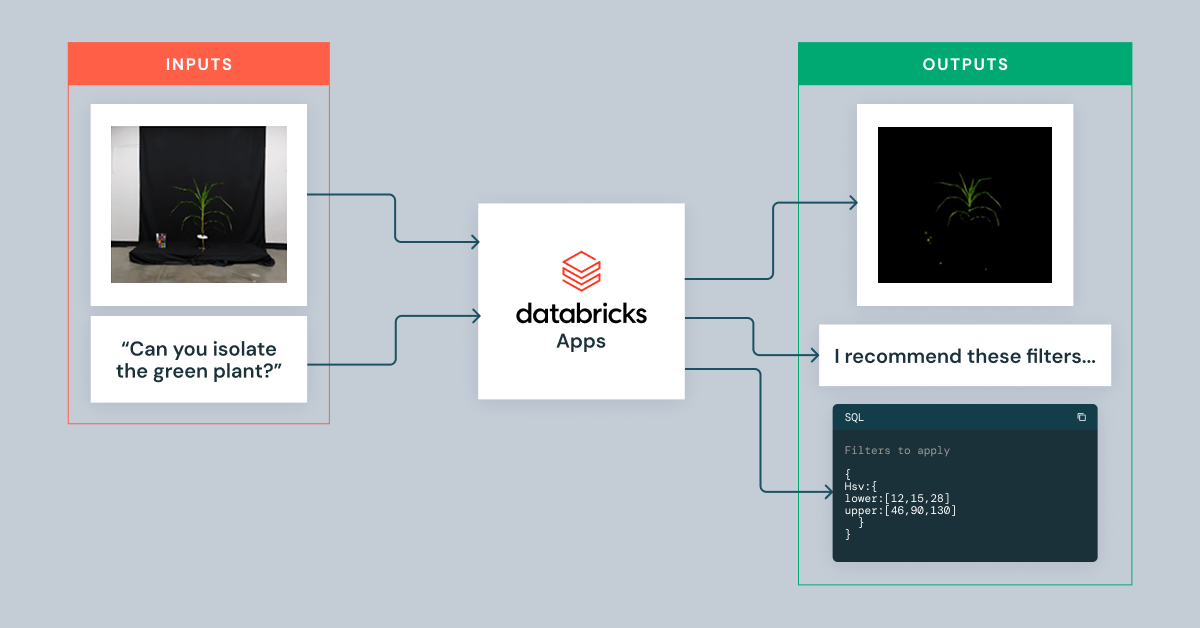2024 Databricks GenAI World Cup Americas Winners: AdaptiveFilters by GreenLight Biosciences

Summary
- GreenLight Biosciences won Databricks' GenAI World Cup by developing AdaptiveFilters, an AI-powered image processing agent that streamlines biopesticide discovery.
- AdaptiveFilters automates image processing using GenAI on Databricks, reducing manual effort, accelerating screening, and enhancing explainability in biotech R&D.
- Future plans include expanding AI capabilities with domain-specific knowledge, integrating open-source models, and improving task-planning for biotech and agritech applications.
GreenLight Biosciences participated in the Generative AI World Cup, a six-week hackathon hosted by Databricks to build an image processing agent that fully leverages the Databricks Data Intelligence Platform. The event brought together over 1500 data scientists and AI engineers from over 18 countries and the GreenLight Biosciences team won the grand prize. The team leveraged cutting-edge GenAI capabilities from Databricks Mosaic AI, including Model Serving, Vector Search, Databricks Notebooks, and Databricks Apps, to create their final product.
Background
A growing world population and the rising environmental impact of climate change necessitate rapid innovations in agriculture to secure our food supply. One key tool to achieve sustainable, environment-friendly, and efficient agriculture is novel biopesticides. These products provide a new mode of action to manage intractable pests while reducing our reliance on chemical pesticides, which can harm humans, the environment, and leave residues on food.1,2
GreenLight Biosciences is a leader in this field with its pioneering bioinsecticide, Calantha. This breakthrough product is a RNA-based pesticide spray tailored to a gene in its intended target which is a new, precise approach that is safer than existing chemicals. Calantha was recently recognized by Science and Popular Science, as well as the farmers who have used it.
However, the process of discovering products like Calantha is long and complex, often involving extended testing in laboratories, greenhouses, and field trials.
Generative AI (GenAI) technology can revolutionize this discovery pipeline by automating the screening process for product leads, significantly speeding up the time it takes to bring novel solutions to farmers. To do this, GreenLight Biosciences uses image capture and processing methods to identify promising molecules. Current image processing technologies often depend on manual identification of parameters, a process that is time-intensive and laborious. High-throughput processes can help address this challenge and enable rapid assessment of new biopesticide’s performance in tasks such as disease monitoring and mass quantification. However, developing such a robust high-throughput image-processing workflow requires substantial investment and expertise, which can be a barrier during the early stages of research and development.
AdaptiveFilters: An Image Processing Agent
To overcome these challenges, GreenLight Biosciences has developed AdaptiveFilters: an Image Processing Agent powered by GenAI. This tool allows users to quickly create image processing pipelines by simply providing an image and a task description. AdaptiveFilters then returns a processed image, recommended filters, and the reasoning behind each choice, offering a clear starting point for further customization and tuning.
How AdaptiveFilters Works
AdaptiveFilters requires only an image and a description of the task to function effectively. For instance, if a user submits an image of a plant and specifies the task as isolating the plant from the background, AdaptiveFilters will provide the isolated image of the plant along with suggested filters and detailed explanations for each filter applied. These filters can then be integrated into a high-throughput image processing pipeline, enabling the automatic processing of multiple images simultaneously.
System Architecture
AdaptiveFilters is a multi-modal GPT4o chat application that is built and operates on the Databricks platform. The system uses a LangGraph workflow with three key agents: Planner, Executor, and Critiquer deployed as a Databricks App. The Planner is responsible for devising a filter and parameter plan, the Executor applies it, and the Critiquer validates it against the user's request. If the output is correct, it is provided to the user; if not, the process is retried.
The Planner is further enhanced with previously generated task-plans via Retrieval-Augmented Generation (RAG) using Databricks Mosaic AI for task embedding and Model Serving.
Successful plans are stored in Vector Search ( vector store), for task-plan similarity lookup which aids in future planning.
Key Benefits
AdaptiveFilters significantly enhances process efficiency for end users by offering filter recommendations, which is currently a manual process. In addition to saving time, which is critically important in a market where products can take 10 years from ideation to launch, this tool also provides a clear rationale, thereby contributing to the advancement of explainable AI.
For technical users, AdaptiveFilters streamlines basic image processing tasks to the app, serves as a platform for deploying proprietary filters, and lays the foundation for developing structured image processing pipelines. These features drive both user-friendliness and technical adaptability.
Future Development
AdaptiveFilters has immense potential to support even more complex tasks by enhancing both the variety and precision of filters. The objective is to integrate domain-specific knowledge into language models, thereby customizing recommendations for applications in biotech and agritech industries. Additionally, leveraging open-source HuggingFace models on Databricks for advanced image analysis and fine-tuning language models with the task-plan dataset will further enhance the AI's overall capabilities.
Conclusion
AdaptiveFilters is an innovative tool developed by GreenLight Biosciences to streamline the identification and development of biopesticides. By leveraging Databricks for Generative AI, AdaptiveFilters automates image processing tasks, resulting in up to a 50% reduction in time spent and a fourfold increase in biopesticide screening throughput. This project highlights the transformative potential of AI in accelerating research and development within agricultural biotechnology, paving the way for sustainable agricultural practices and technologies.
Ready to accelerate your AI-driven research? Discover how Databricks Mosaic AI can transform your industry. Get started today.
1Nchu F. Sustainable Biological Control of Pests: The Way Forward. Applied Sciences. 2024; 14(7):2669. https://doi.org/10.3390/app14072669
2Góngora CE, Silva MdC. Sustainable Strategies for the Control of Crop Diseases and Pests to Reduce Pesticides. Agronomy. 2024; 14(9):2158. https://doi.org/10.3390/agronomy14092158

